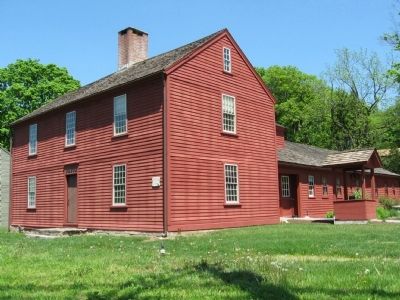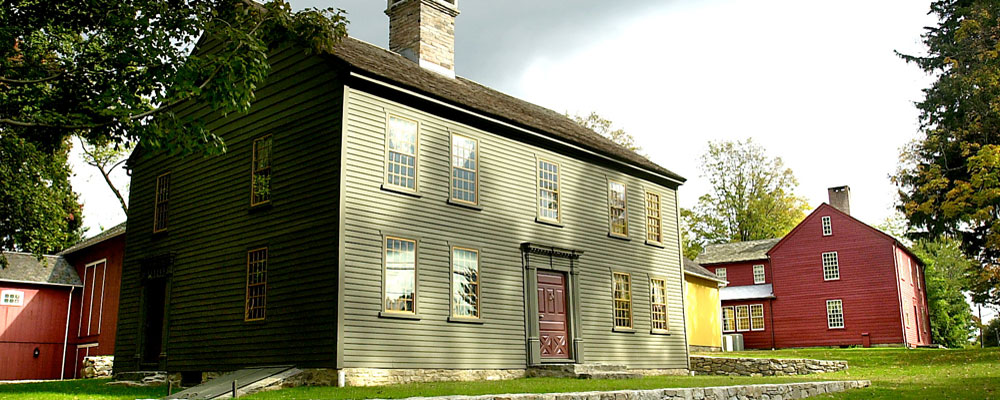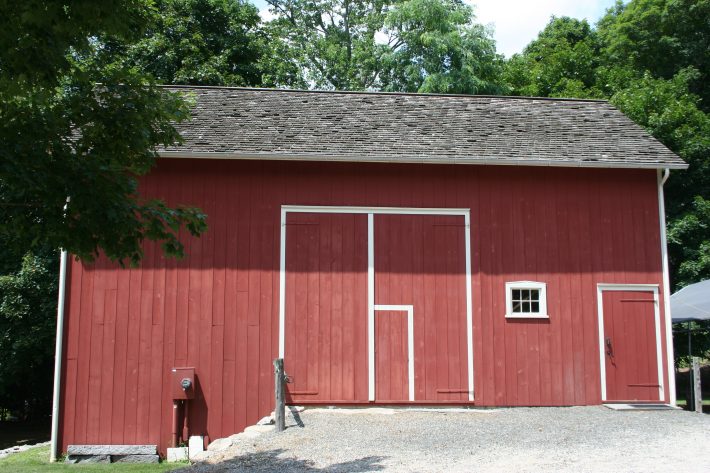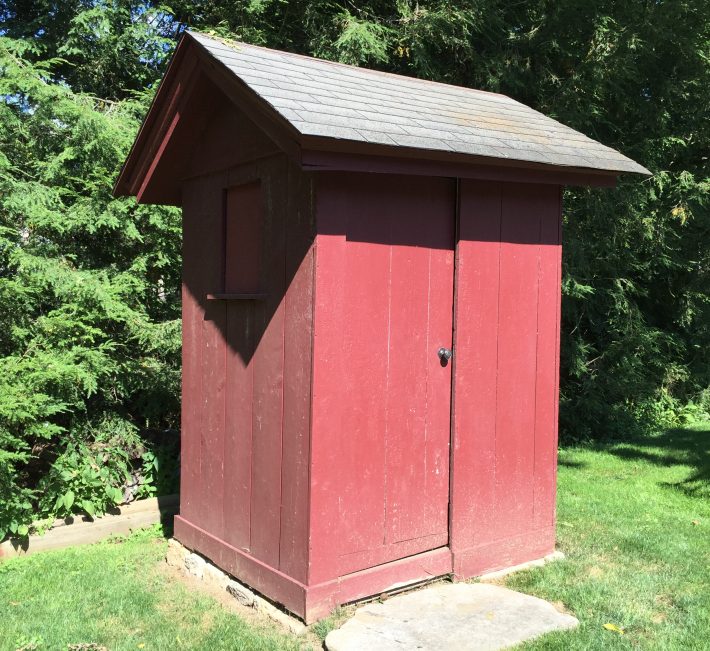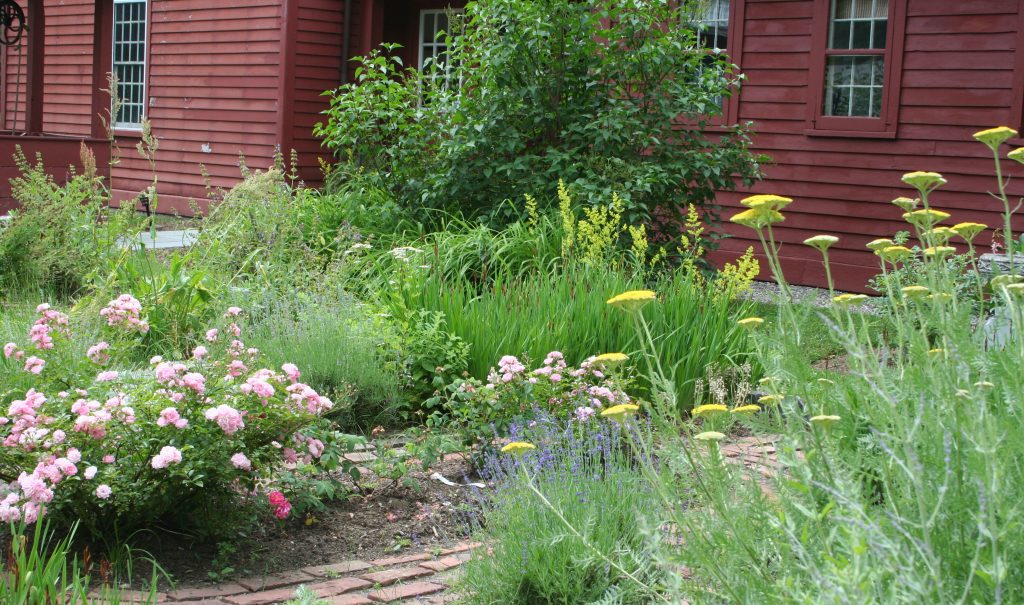Mission
To preserve Wilton’s history, and connect, engage and educate all who would look to the past to shape the future.
Vision
A collaborative organization that is fiscally sound, with an engaged board and membership, inspiring architectural preservation and historical literacy
Museum
Visitors are welcome at the Wilton Historical Society Museum Complex (Historic District #5), which consists of the Betts-Sturgis-Blackmar House (red) built on-site c.1740; the c.1840 Burt Barn Gallery (yellow); the Sloan-Raymond-Fitch House (gray) built c.1770; the c. 1860 Abbott Barn, c. 1890 Blacksmith Shop, plus a c.1895 two-seat privy.
Making connections between objects, places and stories to ensure that history is relevant to everyone, the History is Here permanent exhibition presents a compelling timeline of “Connecticut’s History, Wilton’s Story”. Kids and adults alike love the award-winning “Just Like Grandma Used to Make” room, where you can touch everything! Period rooms and exhibit spaces display objects and collections, such as textiles, costumes, toys, tools, furniture, and redware.
Visitors may tour the historic houses, see the extensive tool collection in the Abbott Barn, and stroll in the 1750 Colonial Herb Garden. Plants in the flourishing garden are well marked as to their name and use, be it culinary, dying, potpourri or medicinal. A blacksmith is generally at his forge on Saturdays. The Burt Barn Gallery and Sloan House Gallery provide space for changing exhibitions, lectures and meetings. The Betts Store, a museum shop featuring hand-crafted, American made gifts and toys, is open during regular museum hours. Tours by appointment.
The two 18th-century dwellings contain 12 rooms furnished to show the development of domestic life, the economy, furniture, and décor in New England homes, 1740-1910. Learn about authentic paint colors, wallpapers, and floor coverings from the Colonial to Victorian eras. Specialized collections include Norwalk-made redware and stoneware and other ceramics; one of the largest collections in the state of the objects of childhood, including dolls, dollhouses and toys; and a large textile and costume collection.
“Tools of the Trades” is a permanent exhibition of more than 600 tools used by the trades common to the area. The tool collection is presented in the c.1860 Abbott Barn, where visitors can see house building and woodworking, broom, shoe, hat, basket-making, coopering, fishing and oystering, hay, grain and ice harvesting tools. Most of these historic tools were contributed from the collection of Walter R. T. Smith (1922 – 2015; tool collector extraordinaire, master builder, building historian and preservationist, Society Emeritus Trustee).
The Great Trains Holiday Show, features multiple train layouts with tiny towns and landscapes, complete with a multitude of buildings, tunnels and surprises! Enchants visitors of all ages with lots of buttons to push and whistles to activate. Runs annually from the day after Thanksgiving to Martin Luther King Day.
The Betts-Sturges-Blackmar House, c. 1740
Elias Betts (1716-1782) built his early Connecticut dwelling around 1740 on land owned by his father, James Sr. The Betts House is a good example of a New England “second period” house. The earliest, first period houses were designed with a single room having a fireplace and a bake oven, and – sometimes- a loft or second floor above. Second period dwellings were typically constructed with a large center chimney, two rooms on the first floor, and two rooms upstairs. Very few second period houses still exist, particularly ones with the heavy framing of the Betts House.
In 1795 one of the Betts’ sons built a new two-story addition with a kitchen on the first floor and a new stairway to the second floor. The new kitchen included a massive 8’x6’ fireplace with two brick beehive ovens at the rear.
Betts House period rooms include a c. 1740 kitchen, a bed chamber c. 1840, an upper chamber furnished as a weaving room, and a late 19th century girl’s bedroom.
The Betts-Sturges-Blackmar House was acquired by the Wilton Historical Society in 1991.
Sloan-Raymond-Fitch House, c. 1770
The prominent Fitch family of Norwalk purchased the house in the 1830’s and occupied it for nearly a century. They expanded the house in 1845, and also attached a circa 1732 structure, the Sloan House, a small First Period House.
The Raymond House portion of the structure — the green façade is seen from Danbury Road (Route 7) — is a fine example of a New England Third Period house. Built in 1772 by Clapp Raymond, the house reflects the growth in the economy. With changes in lifestyle, residents began to add more windows, completely plastered walls, crown molding and raised paneling on the fireplace walls. This is a full two-story house, with a large stone center chimney for its three fireplaces.
The present front door and entry frame are more ornate than would have been typical for a 1772 Wilton country house. Designed by noted Wilton architect Nelson Breed (1890 – 1976), these modifications were made by owner Peter Van Wyck in 1933. Nelson Breed’s work is well known for its well-proportioned Colonial Revival architecture.
The period rooms at the Fitch House include the late 18th century kitchen with a buttery, Federal Dining Room, a c. 1780 parlor, Suzanna Lambert’s c. 1826 bed chamber, and a c.1890 bedroom. There is also a c. 1890 Victorian Music Room. The Society’s extensive collection of Norwalk redware, stoneware and ceramics is on display in the Fitch House pantry.
The Fitch House was previously located ¼ mile north of the Museum Complex, diagonally across the street from Wilton’s Town Hall. When Route 7 was widened in 2001/2002, the house was moved by the state to the current site. Click here for more information about the move, and the Society’s commitment to Preservation.
The period rooms at the Fitch House include the late 18th century kitchen with a buttery, Federal Dining Room, a c. 1780 parlor, Suzanna Lambert’s c. 1826 bed chamber, and a c.1890 bedroom. There is also a c. 1890 Victorian Music Room. The Society’s extensive collection of Norwalk redware, stoneware and ceramics is on display in the Fitch House pantry.
The Fitch House was previously located ¼ mile north of the Museum Complex, diagonally across the street from Wilton’s Town Hall. When Route 7 was widened in 2001/2002, the house was moved by the state to the current site. Click here for more information about the move, and the Society’s commitment to Preservation.
The period rooms at the Fitch House include the late 18th century kitchen with a buttery, Federal Dining Room, a c. 1780 parlor, Suzanna Lambert’s c. 1826 bed chamber, and a c.1890 bedroom. There is also a c. 1890 Victorian Music Room. The Society’s extensive collection of Norwalk redware, stoneware and ceramics is on display in the Fitch House pantry.
Abbott Barn, c. 1860 and Blacksmith Shop, c. 1890
An integral part of every New England homestead was the barn, and an important craftsman in every community was the blacksmith. In 1999 the Society relocated the George Abbott barn and blacksmith shop from Hurlbutt Street in Wilton to save them from demolition.
The barn, originally built in the mid-19th century, features an outstanding permanent exhibit “Tools of the Trade,” curated by the late Walter R.T. Smith (tool collector extraordinaire, master builder, building historian and preservationist, 1922 -2015) and drawn from his extensive collection. With more than 600 tools, a multitude of typical 18th and 19th century trades are explored. There is an emphasis on tools with a local provenance and those made by the G.W. Bradley Company of Weston, founded 1812.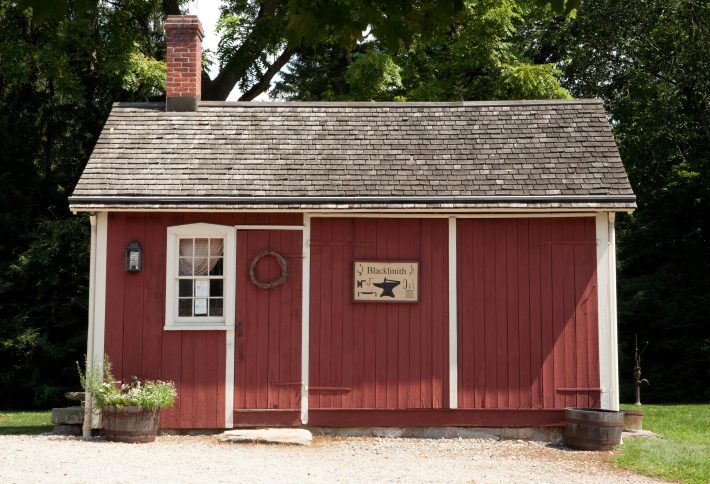
The fully operational mid-19th century Abbott Blacksmith shop features a working blacksmith (on most Saturdays, depending on weather) using period tools, making wrought-iron items for the hearth and home.
Godfrey Outhouse, c.1890 – 1910
This two-seater was given by Wilton’s Quigley family.
1750 Colonial Herb Garden
The Colonial herb garden at the Betts House, splashed with color and fragrant with lavender and thyme, is a sight to behold in the summer. The garden, divided into sections for dyeing, potpourri, culinary, and medicinal herbs, historically accurate to the year 1750. Some of the interesting plants that can be seen in the garden include Penny Royal (Mentha pulegium) a mint flavoring for soup; Rue (Ruta graveolens) for joint stiffness; Skirret (Sium sisarum) a flavoring for stews; and Wrinkled Rose (Rosa rugosa ‘rubra’) which provides Vitamin C to prevent scurvy. A volunteer team of fantastic Master Gardener interns keep the garden in tip-top shape.

